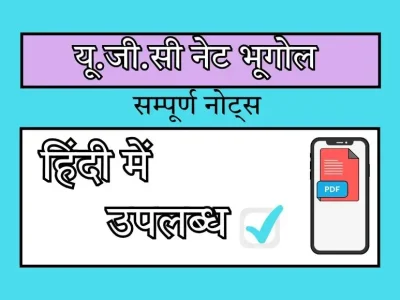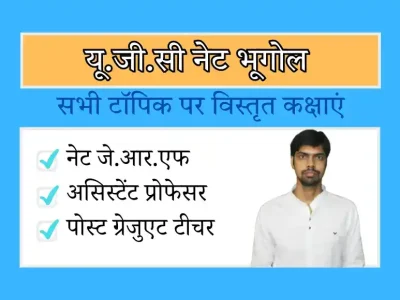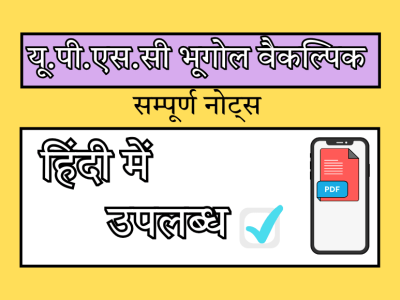Note – Human Geography Course is included in this course.
Geography Optional Online Classes have been designed according to the UPSC syllabus and the UPPCS syllabus has also been covered. The course is in the Hindi Language with Hindi PDF Notes. PDF Notes are also available in English for English Medium Students.
Special features of the course –
- चित्र और स्पष्ट स्पष्टीकरण के साथ वीडियो कक्षाएं
- स्पष्ट रूप से टाइप किए गए पीडीएफ नोट्स
- भूगोल से संबंधित करेंट अफेयर्स को कवर किया जाएगा
- यूपीएससी प्रश्न पत्र की प्रवृत्ति के अनुसार डिजाइन की गई कक्षाएं
- यह आप में विश्लेषणात्मक क्षमता विकसित करेगा
Course Features
- Lectures 381
- Quiz 0
- Duration 72 weeks
- Skill level All levels
- Students 726
- Assessments Yes
- 25 Sections
- 381 Lessons
- 72 Weeks
- 3 March 2022 (Important Information Added)3
- Paradigms in Geography32
- 2.1Importance Of Optional For Your Success in Civil Services
- 2.2Determinism
- 2.3Effect of Climate Change on Determinism (Geopolitics of Climate Change)
- 2.4Possibilism
- 2.5Criticism Of Possibilism
- 2.6Neo Determinsm
- 2.7Probabilism
- 2.8Cultural Determinism
- 2.9Determinsim To Suntainble Development Goals
- 2.10Dualism In Geography – (Systematic Vs Regional Geography) – Part 1
- 2.11Dualism In Geography – (Systematic Vs Regional Geography) – Part 2
- 2.12Areal Differentiation
- 2.13Exceptionalism In Geography
- 2.14Quantitative Revolution
- 2.15Quantitative Revolution – Part 2
- 2.16Quantitative Revolution _ Critical Evaluation
- 2.17Spatial Analysis
- 2.18Locational Analysis
- 2.19Positivism – Contemporary Movements In Geography
- 2.20Positivism – Criticism
- 2.21Pragmatism
- 2.22Existensialism
- 2.23Functionalism
- 2.24Idealism
- 2.25Structuralism
- 2.26Realism In Geography
- 2.27System Analysis
- 2.28Postmodernism In Geography
- 2.29Feminism In Geography
- 2.30Mental Maps In Geography
- 2.31Dualism Idiographic vs Nomothetic
- 2.32Dualism Historical Vs Contemporary
- School Of Thoughts - German, Russian, French, Indian etc.10
- 3.1German School Of Thoughts Part – 1
- 3.2German School Of Thoughts Part – 2
- 3.3German School Of Thoughts Part – 3
- 3.4French School Of Thoughts Part – 1
- 3.5French School Of Thoughts Part – 2
- 3.6British School Of Thought Part – 1
- 3.7British School Of Thought Part – 2
- 3.8Indian School Of Thoughts Part – 1
- 3.9Indian School Of Thoughts Part – 2
- 3.10American School Of Thoughts
- Population Geography24
- 4.1Demographic Transition Theory
- 4.2Demographic Transition Theory and Present World
- 4.3Demographic Transition Theory and India
- 4.4Demographic Transition Criticism
- 4.5Theory of Malthus
- 4.6Relevance Of Malthusian Theory in India and World
- 4.7Neo Malthusian Theory
- 4.8Herbert Spencer’s Population Theory
- 4.9Population Theory By Karl Marx
- 4.10Developing Analytical Ability
- 4.11Optimum Population Theory
- 4.13Demographic Dividend
- 4.14Old Age Population Of World
- 4.15Population Structure Of World Part 1
- 4.16Population Structure Of World Part 2
- 4.17Population Policies in World Part 1
- 4.18Population Policies in World Part 2
- 4.19Demographic Attributes
- 4.20Age Structure and Population Pyramid
- 4.21Effects of Various Factors on Population Density
- 4.22Fertility Rate of Bangladesh
- 4.23Differential Mortality
- 4.24Ecumene And Non Ecumene
- 4.25Endogenetic And Exogenetic Reasons Of Death
- Migration Geography17
- 5.1Migration Introduction
- 5.2Differential Migration’
- 5.3Forced Migration
- 5.4Models Of Migration – Introduction
- 5.5Gravity Model_Deterministic Models_Models of Migration
- 5.6Ravenstine’s Rules of Migration_Deterministic Models
- 5.7Zelinksy’s Transition Theory of Migration_Deterministic Models’
- 5.8Todaro’s Model of Migration_Neo Classical Approach
- 5.9Wolpert’s Model of Migration_Behavioural Model
- 5.10Lee’s Theory of Migration_Behavioural Model
- 5.11Marxist Models_Behavioural Structural Models
- 5.12Taylor_ System Approach _Models of Migration
- 5.13Stouffer_ System Approach _Models of Migration
- 5.14Social Well Being Part 1
- 5.15Social Well Being Part 2
- 5.16Quality of Life
- 5.17Social Capital
- Economic Geography18
- 6.1Theory of Absolute Advantage – World Trade Pattern
- 6.2Gravity Model – World Trade Pattern
- 6.3Principle Of Relative Advantage – World Trade Pattern
- 6.4India – Comparative Advantage – World Trade Pattern
- 6.5India – Comparative Advantage – World Trade Pattern
- 6.6Heckscher – Ohlin Trade Theory – World Trade Pattern
- 6.7Economic Development – Measurement And Problems
- 6.8Economic Development – Measurement And Problems – Part 2
- 6.9Concept of Resources – Zimmerman
- 6.10Energy Crisis
- 6.11Agricultural Regionalization (Delimitation of Agricultural Regions)
- 6.12Different Approaches in Agricultural Regionalization
- 6.13Crop Combination Regionalization Method
- 6.14Agricultural Productivity
- 6.15Agricultural Regions – Whittelsey
- 6.16Model Of Von Thunen
- 6.17Model Of Von Thunen Relevance
- 6.18Whittelsey
- Settlement Geography25
- 7.1Rural Settlements Introduction and Classification
- 7.2Factors Influencing Rural Settlement
- 7.3Types of Rural Settlement
- 7.4Rural Urban Continuum
- 7.5Distribution of Rural Settlement
- 7.6Commuter Villages and Second Homes
- 7.7Planned Rural Settlements
- 7.8Urban Settlements – Emergence
- 7.9Functional Classification Of Urban Settlements Part 1 – Important
- 7.10Functional Classification of Urban Settlements Part 2 – Less Important
- 7.11Functional Classification of Urban Settlements Part 3 – Nelson and Aurousseau
- 7.12Functional Classification of Urban Settlements – A.K.Mitra
- 7.13Rank Size Rule and Apllicability in India and World
- 7.14Primate City
- 7.15Hierarchy of Urban Settlements
- 7.16Central Place Theory – Christaller
- 7.17Central Place Theory – Applicability in India
- 7.18Central Place Theory – Modification By Losch
- 7.19CBD
- 7.20CBD Case Studies
- 7.21Urban Sprawl
- 7.22Rural Urban Fringe
- 7.23Satellite City
- 7.24Suburbs
- 7.25Area of Influence of Umland
- Regional Geography15
- 8.1Concept of Region – Formal, Functional And Vernacular
- 8.2Methods for the delineation of Formal Regions
- 8.3Methods for the delineation of Functional and Planning Regions
- 8.4Growth Pole and Growth Centre
- 8.5Growth Pole and Growth Centre Applicability and Criticism
- 8.6Core Periphery Model
- 8.7Hirschman’s Trickling Down Effect
- 8.8Gunnar Myrdal
- 8.9Stages of Growth – Model by Rostow
- 8.10Model by Rostow – Applicability
- 8.11Limits to Growth Model by Forrester Meadows
- 8.12Mesarovic Pestel Model
- 8.13Diffusion Of Innovation
- 8.14Diffusion Of Innovation Hager-strand’s Model
- 8.15Regional Imbalance and Regional Development Strategies
- Political Geography8
- Geomorphology - Endogenetic Forces (Complete) - Paper 1 and Paper 245
- 10.1Geomorphology – Definition And Development – World Geography
- 10.2Recent Trends in Geomorphology – World Geography
- 10.3Geological History of Earth – World Geography
- 10.4Theory of Uniformitarianism – World Geography
- 10.5Exogenic And Endogenic Forces – World Geography
- 10.6Rocks – Formation Part 1 – World Geography
- 10.7Rocks – Formation Part 2 – World Geography
- 10.8Indian Rock System Part 1 – Indian Geography
- 10.9Indian Rock System Part 2 – Indian Geography
- 10.10Indian Rock System Part 3 – Indian Geography
- 10.11Continent and Ocean Formation Theories – Tetrahedral Hypothesis
- 10.12Continent and Ocean Formation Theories – Continental Drift Theory
- 10.13Interior Of The Earth
- 10.14Geomagnetism
- 10.15Plate Tectonics – Lithosphere, Aesthenosphere and Plate Boundaries – 25 Feb
- 10.16Sea Floor Spreading
- 10.17Wilson Cycle
- 10.18Movements of Continents – Plate Tectonics
- 10.19Mountain Building – Plate Tectonics
- 10.20Mountain Ranges of The World – Part 1
- 10.21Mountain Ranges of The World – Part 2
- 10.22Mountain Ranges of The World – Part 3
- 10.23Trenches
- 10.24Major Volcanic Belts Of World
- 10.25Volcano – Plate Tectonic
- 10.26Types of Volcano
- 10.27Earthquake
- 10.28Fold
- 10.29Fault
- 10.30Isostasy
- 10.31Isostasy – Part 2
- 10.32Isostasy – Part 3
- 10.33Geosynclines
- 10.34Kober – Theory of Orogen
- 10.35Jeffrey’s Theory of Mountain Building
- 10.36Arthur Holmes Theory of Mountain Building
- 10.37Movement of Indian Peninsula – Indian Geography
- 10.38Earthquake in India
- 10.39Volcano In India
- 10.40Himalayan Ranges
- 10.41Aravalii
- 10.42Malwa Plateau
- 10.43Vindhya and Satpura
- 10.44Deccan and Meghalaya Plateau
- 10.45Chota Nagpur Plateau
- Geomorphology - Exogenetic Forces - Paper 1 and Paper 2 (Only Karst Topography Remaining)10
- 11.1Model Of Davis
- 11.2Weathering
- 11.3Mass Wasting
- 11.4Effects of Climate on Morphologic Processes
- 11.5Slope – Davis
- 11.6Slope – Penck
- 11.7Video From YouTube (Erosional Landforms By River)
- 11.8Video From YouTube (Arid Cycle Of Erosion And Landforms)
- 11.9Video From YouTube (Landforms Made By Glaciers)
- 11.10PDF For YouTube Classes
- Climatology27
- 12.1Compete Notes By IGNOU
- 12.2L1
- 12.3L2
- 12.4L3 – Heat Budget
- 12.5L4 – Factors Responsible For Atmospheric Temperature
- 12.6L5 – Isotherms
- 12.7L6 – Isobars
- 12.8L6 – Temperature Inversion
- 12.9L7 – Corriolis Force, Geostrophic Winds, Tricellular Circulation
- 12.10L8 – Geostrophic Winds (Answer Writing)
- 12.11L9 – Real Wind System
- 12.12L10 – Monsoon Of East Asia
- 12.13L11 – Local Winds
- 12.14L12 – Adiabatic Lapse Rate
- 12.15L13 – Humidity
- 12.16L14 – Fog
- 12.17L15 – Clouds
- 12.18L16 – Fronts
- 12.19L16.1 – Airmasses
- 12.20L17 – Rainfall
- 12.21L18 – Jet Streams
- 12.22L19 – Temperate Cyclone
- 12.23Tornado
- 12.24Thunderstorm
- 12.25Anticyclone
- 12.26Tropical Cyclone
- 12.27Heat Wave and Cold Wave
- Biogeography - Paper 1 and Paper 2 - Complete11
- Oceanography - Completed22
- 14.1Oceanography Basics
- 14.2Ocean Floor – Continental Shelf, Slope, Canyon
- 14.3Sea Floor Of Atlantic Ocean
- 14.4Sea Floor Of Pacific Ocean
- 14.5Sea Floor Of Indian Ocean
- 14.6Temperature Of Ocean
- 14.7Salinity Of Ocean
- 14.8Tides
- 14.9Theories Of Tides
- 14.10Density Of Ocean Water
- 14.11Depositional Landforms In Ocean
- 14.12Classification Of Costs And Shorelines
- 14.13Ocean Waves
- 14.14Deposition In Ocean
- 14.15Ocean Water Circulation Part 1
- 14.16Ocean Water Circulation Part 2 (Two Classes Inside)
- 14.17Atlantic Ocean Current
- 14.18Pacific Ocean Current
- 14.19Indian Ocean Current
- 14.20Deep Ocean Water Mass
- 14.21Coral Reef – 2 Classes Inside
- 14.22Ocean Resources – Notes Only
- Transport Geography Paper 2 - Complete8
- Indian Geography - Paper 2 - Resources + Industry - Completed28
- 16.1Energy Resources – Coal In India
- 16.2Mineral – Bauxite
- 16.3Biotic and Marine Resources
- 16.4Land and Water Notes
- 16.6Forest And Wildlife Resources and Their Conservation Notes
- 16.7Energy crisis
- 16.8Energy Resources – Coal Policy
- 16.9Industry – Aluminium
- 16.10Energy Resources – Natural Gas
- 16.11Oil Refinery
- 16.12Fertilizer Industry
- 16.13Industry – Ship Manufacturing
- 16.14Industry – Pulp And Paper
- 16.15Cement Industry
- 16.16Cotton And Textile Industry
- 16.18Sea Weed
- 16.19SEZ India
- 16.20Solar Energy – Current
- 16.21Tourism Sector In India
- 16.22Degraded Land
- 16.23Eco Tourism
- 16.24Locational Factors Of Industries
- 16.25Jute Industry and Automobile Industry
- 16.26Very Important Notes
- 16.27Industrial Regions – Download Notes
- 16.28Weber’s Model Of Industrial Location
- 16.29Industrial Complexes – Download Notes
- 16.30Industrial Policy Of India Notes
- Indian Geography - Paper 2 - Agriculture - Completed - Updated On 15th November23
- 17.1Institutional factors: land holdings, land tenure and land reforms
- 17.2Cropping Pattern – Updated
- 17.32 Video Classes Inside – Agricultural Productivity
- 17.4Agricultural Intensity
- 17.5Crop Combination
- 17.6Land Capability
- 17.7Agro and social-forestry – Already Covered
- 17.9Significance of dry farming
- 17.10Livestock resources and white revolution
- 17.11Aquaculture – 2 Classes Inside
- 17.12Sericulture
- 17.13Apiculture and poultry
- 17.14Agricultural regionalisation
- 17.15Agro-climatic zones
- 17.16Agro- ecological regions
- 17.17Seed – 2 Videos In This Class
- 17.18Different Irrigation System
- 17.19Irrigation In India
- 17.20Power
- 17.21Fertilizer
- 17.22Bio Fertilizer
- 17.23Pulses Production In India
- 17.24Wool And Sheep
- Cultural Setting Paper 2 - Completed13
- 18.1Historical Perspective of Indian Society
- 18.2Notes – Indian Culture
- 18.3Religious Minorities Of India
- 18.4Racial Diversity Of India
- 18.5Tribes Of India
- 18.6Population Policy Of India
- 18.7Cultural Regions Of India
- 18.8Problems Of Tribal Region
- 18.9India Population Attributes
- 18.10Demographic Dividend
- 18.11Sex Ratio
- 18.12Life Expectancy In India
- 18.13Migration In India
- Regional Planning In India - Completed14
- 19.1Experience of regional planning in India, Five Year Plans Part 1
- 19.2Experience of regional planning in India, Five Year Plans Part 2
- 19.3Multilevel Planning
- 19.4Decentralization Part 1
- 19.5Decentralization Part 2
- 19.6Integrated Rural Development Scheme
- 19.7Regional planning and development of island territories
- 19.8Command Area Development
- 19.9Backward Region Development
- 19.10Desert Area Development Programme
- 19.11Drought Prone Area Development Programme
- 19.12Hill Area Development Programme
- 19.13Tribal Area Development Programme
- 19.14Watershed Management
- Indian Settelments - Rural And Urban - Completed7
- Political Geography Of India - Completed17
- 21.1Geographical Basis Of Indian Federalism
- 21.2State Reorganization
- 21.3Boundary Disputes And Regional Conciousness – Maharashtra And Karnataka
- 21.4Boundary Disputes And Regional Conciousness – Assam – Arunachal
- 21.5Boundary Disputes And Regional Conciousness – Assam – Meghalaya
- 21.6Boundary Disputes And Regional Conciousness – Assam – Mizoram
- 21.7Boundary Disputes And Regional Conciousness – Assam – Nagaland
- 21.8India China Border Dispute
- 21.9India Bangladesh Border Dispute
- 21.10India Myanmar (World Affairs and Role Of India)
- 21.11Notes (World Affairs and Role Of India)
- 21.12India Pakistan Border Dispute
- 21.13India Nepal Border Dispute
- 21.14Geopolitics Of Indian Ocean
- 21.15RCEP
- 21.16Emergence Of Taliban
- 21.17Cross Border Terrorism
- Mapping - Exercises1
- Optional Geography Answer Writing - YouTube Classes1
- Analytical Ability1
- Practice Questions1



